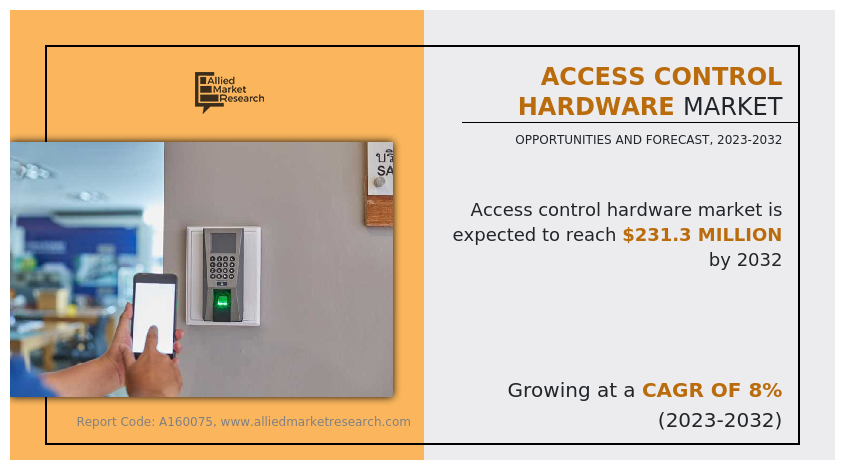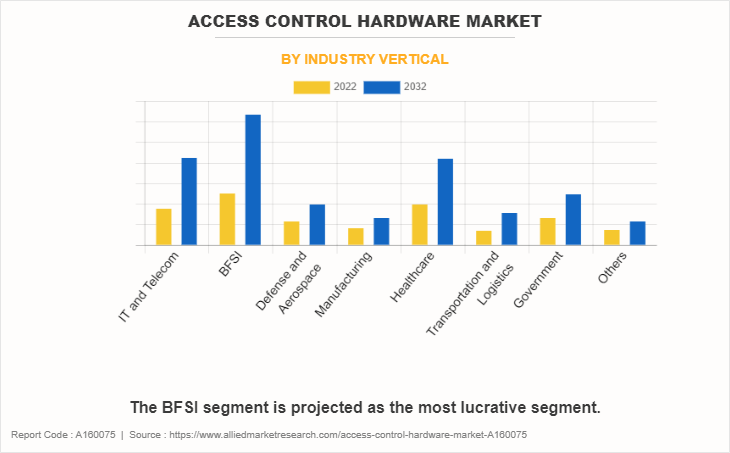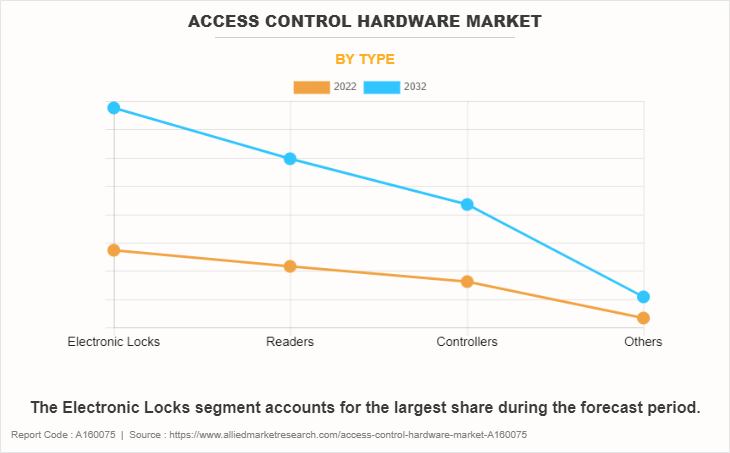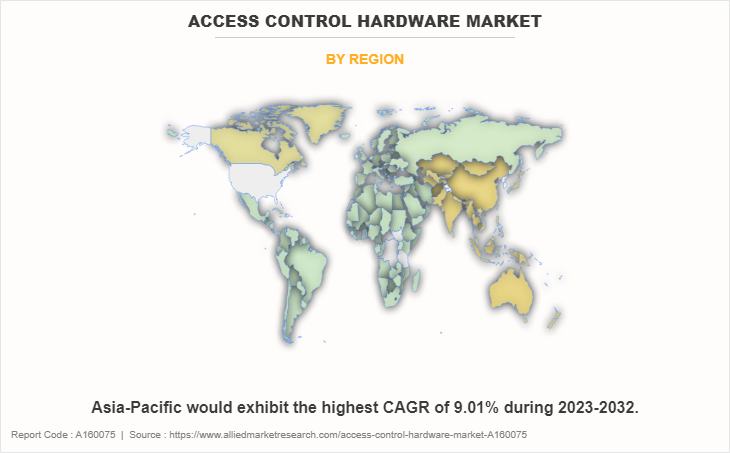Access Control Hardware Market Research, 2032
The global access control hardware market was valued at $108.3 million in 2022 and is projected to reach $231.3 million by 2032, growing at a CAGR of 8% from 2023 to 2032.
Access control hardware refers to the physical devices and components used to manage and restrict entry to buildings, rooms, or specific areas within a facility. These systems are designed to enhance security and control access by allowing or denying entry to authorized personnel while keeping unauthorized individuals out. Access control hardware can be found in various environments, including commercial buildings, offices, government facilities, educational institutions, and residential properties.
The primary purpose of access control hardware is to restrict and authorize entry or use based on predefined permissions, which can include granting or denying access to individuals or groups of users. Common components of access control hardware include access control panels, card readers, keypads, biometric scanners, electric locks, exit devices, request-to-exit (RTE) devices, door position sensors, door contacts, intercoms, CCTV cameras, turnstiles and gates, alarm systems, etc.

The access control hardware market is segmented into Industry Vertical and Type.
By industry vertical, the access control hardware industry is fragmented into IT & telecom, BFSI, defense & aerospace, manufacturing, healthcare, transportation & logistics, government, and others.

By type, the access control hardware market is categorized into electronic locks, readers, controllers, and others.

By region, the access control hardware market is analyzed across North America (U.S., Canada, and Mexico), Europe (UK, Germany, France, and the rest of Europe), Asia-Pacific (China, Japan, India, South Korea, and rest of Asia-Pacific) and LAMEA (Latin America, Middle East, and Africa).

Country-wise, the U.S. has acquired a prime access control hardware market share in the North American region and is expected to grow at a significant CAGR during the forecast period of 2023-2032. This dominant position can be attributed to several key factors. The U.S. possesses a mature and technology-driven economy, fostering a conducive environment for the adoption of advanced access control solutions. Moreover, the nation's heightened focus on security across various sectors, including commercial, industrial, and residential, amplifies the demand for robust access control systems. The U.S. also boasts a robust ecosystem of technology providers, research institutions, and regulatory bodies, fostering innovation and compliance with evolving security standards. These factors collectively contribute to the U.S.'s prime market share and its anticipated growth trajectory in the access control hardware sector.
In Europe, the UK emerged as the dominant player in terms of revenue share in the access control hardware market in 2022, and this trend is expected to continue during the forecast period. UK's emergence as the dominant player in the access control hardware market in Europe can be attributed to several factors. The UK's dominance in this realm can be attributed to multifaceted factors. Beyond its robust economy and technological advancement, the UK benefits from its cultural diversity, fostering innovation and the dynamic adoption of access control solutions tailored to varying requirements. Furthermore, its strategic position as a global financial center and its ongoing investments in smart city initiatives drive demand for cutting-edge security systems. The UK's commitment to research and collaboration, demonstrated by partnerships between academia and industry, bolsters its leadership in this sector. Collectively, these elements underscore the UK's premier status and sustained influence in the European access control hardware market.
In the Asia-Pacific region, China is anticipated to become a prominent market for the access control hardware industry, projected to experience the highest CAGR during the forecast period from 2023 to 2032. This prominence can be attributed to several factors. Beyond its expansive economy and technological prowess, China's rapid urbanization and infrastructural development stimulate the demand for advanced access control systems across commercial, residential, and industrial sectors. Additionally, the government's emphasis on bolstering security and surveillance capabilities, coupled with initiatives to foster domestic innovation, further propels the adoption of cutting-edge access control solutions. China's thriving manufacturing ecosystem, strong consumer base, and strategic investments in emerging technologies collectively contribute to its anticipated dominance in the access control hardware market within the Asia-Pacific region.
In the LAMEA region, Latin America dominated the access control hardware market share in terms of revenue in 2022 and also holds the highest projected compound annual growth rate during the forecast period. This dominance can be attributed to several factors. Latin America's vibrant culture and business landscape foster a robust demand for access control solutions tailored to the region's unique challenges. Moreover, the region's increasing focus on sustainable urban development and the integration of technology for societal progress contribute to the growing need for advanced security measures, driving the adoption of cutting-edge access control technologies. Latin America's concerted efforts to address urbanization complexities, coupled with its commitment to elevating security standards, position it as a pivotal player in the LAMEA access control hardware market.
The access control hardware market is witnessing significant growth due to the increasing security concerns faced by businesses and organizations worldwide. With a surge in security threats and the heightened risk of unauthorized people getting in, there is a pressing need to implement robust access control solutions. These concerns span a broad spectrum, encompassing not only physical security at entry points like doors and gates but also extending digital security measures for protecting sensitive data and confidential information from potential cyberattacks. As a result, companies are actively investing in advanced access control hardware to strengthen their security infrastructure and ensure complete protection across both physical and digital domains, contributing significantly to the access control hardware market growth.
However, one key restraint in the access control hardware market is the lack of awareness among users regarding the benefits of advanced security solutions. Many users are not fully informed about the latest technological features and upgrades available in modern access control systems. As a result, they may not be utilizing these systems to their full potential. Moreover, the absence of knowledge about advanced biometric features, such as iris scanners, and other sophisticated options further limits the adoption of more secure access control solutions. Users relying on traditional access control systems may encounter inconveniences, as these systems can become slow and vulnerable to cyberattacks without regular technological updates.
Despite facing challenges in the market, access control hardware is experiencing a surge in demand for residential applications which creates access control hardware market opportunity. Access control solutions are no longer limited to commercial or industrial spaces; they are now gaining popularity in residential settings as well. Homeowners are recognizing the value of enhanced home security and convenience offered by access control technology, particularly with the integration of smart locks and video doorbells. Access control locks are used to restrict entry based on authorized permissions. These innovative solutions provide homeowners with greater control over their home's security, allowing them to remotely monitor access and ensure the safety of their properties.
Top Impacting Factors
The adoption of smart homes and smart building systems serves as a driver for the access control hardware market, fueled by the increasing popularity of IoT and the need for enhanced security and convenience. Additionally, the ongoing urbanization and infrastructure development further contribute to the market's growth, particularly in commercial buildings and public spaces where security and traffic management are paramount. However, the high initial costs pose a restraint, particularly for smaller businesses. Moreover, there is an opportunity for mobile access control solutions. These solutions offer convenient and credential-free access management through smartphones.
Competitive Analysis
The access control hardware market outlook report highlights the highly competitive nature of the access control hardware market, owing to the strong presence of existing vendors. Vendors with extensive technical and financial resources are expected to gain a competitive advantage over their counterparts by effectively addressing market demands. The competitive environment in this market is expected to increase as product launches, collaborations, partnerships, acquisitions, integrations, and new product development strategies adopted by key vendors increase. Competitive analysis and profiles of the major access control hardware market players that have been provided in the report include Bosch Security System Inc., Cisco Systems Inc., Hanwha Techwin Co. Ltd., Honeywell International Inc., Johnson Controls, Schneider Electric SE, Siemens AG, Southco, Inc., Suprema Inc., and Thales Group (Gemalto NV).
Key Developments/ Strategies
According to the latest access control hardware market forecast, Honeywell International Inc., Johnson Controls, Cisco Systems Inc., Siemens AG, and Suprema Inc. are the top players in the access control hardware market. Top market players have adopted various strategies, such as product launches, collaborations, partnerships, acquisitions, integrations, and new product developments to expand their foothold in the access control hardware market.
In March 2023, Suprema showcased its integrated security solutions in ISC West 2023 in Las Vegas. It exhibited a number of security solutions comprising access control devices managed by BioStar 2. It is an integrated security software platform, which links all of Suprema’s access control terminals and supports multiple credentials seamlessly, including RFID and mobile, QR codes, barcodes, facial recognition, and fingerprint recognition.
In March 2022, Cisco launched its cloud-delivered, integrated platform, which serves to secure and connect organizations of all shapes and sizes. This platform, known as the Cisco Security Cloud, is an open architecture designed to safeguard the integrity of the entire IT ecosystem without imposing any public cloud lock-in.
In April 2021, Pelion, the Connected IoT Device service provider, and subsidiary of Arm, announced a partnership with Johnson Controls. This partnership accelerated innovation in connectivity, security, and intelligence at the edge for Johnson Controls. This partnership combines Johnson Controls' deep domain expertise in healthy buildings with Pelion’s device and edge management capabilities to usher in an era of truly smart, updateable facilities at the cloud scale.
Key Benefits for Stakeholders
This study comprises an analytical depiction of the access control hardware market size along with the current trends and future estimations to depict the imminent investment pockets.
The overall access control hardware market analysis is determined to understand the profitable trends to gain a stronger foothold.
The report presents information related to key drivers, restraints, and opportunities with a detailed impact analysis.
The access control hardware market forecast is quantitatively analyzed from 2022 to 2032 to benchmark the financial competency.
Porter’s five forces analysis illustrates the potency of the buyers and suppliers in the access control hardware market.
The report includes the share of key vendors and access control hardware market trends.
Access control hardware Market Report Highlights
| Aspects | Details |
| Market Size By 2032 | USD 231.3 million |
| Growth Rate | CAGR of 8% |
| Forecast period | 2022 - 2032 |
| Report Pages | 241 |
| By Industry Vertical |
|
| By Type |
|
| By Region |
|
| Key Market Players | Bosch Security Systems, LLC., Thales Group (Gemalto NV), Johnson Controls, Siemens AG, Suprema Inc., Schneider Electric SE., Hanwha Vision Co., Ltd. (Hanwha Group), Southco, Inc., Honeywell International Inc., Cisco Systems Inc. |
Analyst Review
The access control hardware market is projected to experience significant growth during the forecast period. This growth can be attributed to several key factors. There is a growing emphasis on security and safety in various industries, leading businesses to invest in robust access control solutions to protect their assets and personnel from security breaches and unauthorized access. Additionally, the increasing trend of smart buildings and IoT integration has fueled the demand for access control hardware that can seamlessly work with other building systems, optimizing facility management. Moreover, industries like education and construction are recognizing the benefits of access control systems for manpower management and overall security, further driving access control hardware market growth. Regulatory requirements and industry standards also play a significant role in encouraging the adoption of access control hardware across sectors. As a result, companies and organizations are increasingly investing in access control solutions to create secure and efficient environments for their operations, contributing to the market's expansion.
Some of the key players profiled in the report include Bosch Security System Inc., Cisco Systems Inc., Hanwha Techwin Co. Ltd., Honeywell International Inc., Johnson Controls, Schneider Electric SE, Siemens AG, Southco, Inc., Suprema Inc., and Thales Group (Gemalto NV). These players have adopted various strategies to increase their market penetration and strengthen their position in the access control hardware industry.
The Access control hardware Market is expected to grow at a CAGR of 7.98% during the period of 2023 to 2032.
The leading application of the Access control hardware Market is in the field of BFSI.
Asia-Pacific is the largest regional market for Access control hardware.
The industry size of Access control hardware is estimated to be $108.3 million in 2022.
The top companies holding significant market share in the Access control hardware industry include Honeywell International Inc., Johnson Controls, Cisco Systems Inc., Siemens AG, and Suprema Inc.
Loading Table Of Content...
Loading Research Methodology...


